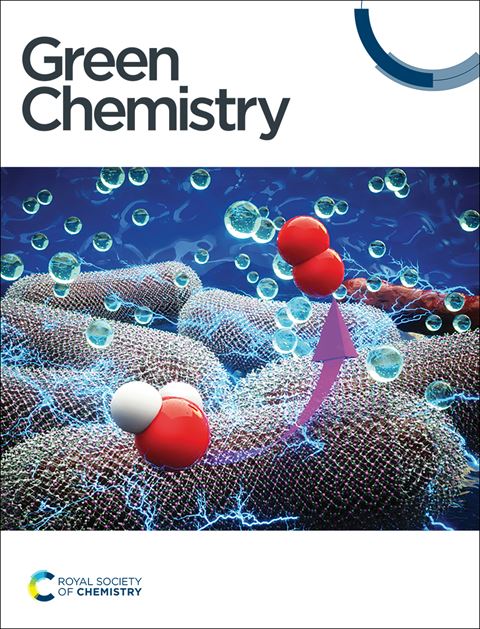采用温和碱性氧化系统的一锅木质纤维素分馏,实现高效全糖转化和芳香单体生产†
IF 9.2
1区 化学
Q1 CHEMISTRY, MULTIDISCIPLINARY
引用次数: 0
摘要
在一锅生物精炼厂中,在保留高度可接近的碳水化合物底物的同时,靶向提取天然木质素是一种有前途的策略,但存在技术挑战。在这项研究中,一个温和的碱氧化体系(四甲基氢氧化铵/尿素过氧化氢,TMAH/UHP)被定制,以分离木质纤维素为原木质素和富含碳水化合物的底物,进一步可再生能源升级。在TMAH/UHP生物精炼过程中,研究了不同的反应强度和溶剂浓度,以实现木质素结构完整性和有价碳水化合物回收率之间的平衡。通过对木质素结构演化的详细研究,了解TMAH/UHP系统如何高效提取原木质素并保持碳水化合物固体的高可及性。通过木质素-碳水化合物酯键的主要裂解,获得了β-O-4键含量高(45.1% ~ 62.8%)的原木质素。此外,碳水化合物的高回收率实现了良好的全糖转化能力(葡萄糖收率为100.0%,木糖收率为50.0%),并且原木质素通过催化氧化过程表现出可行的下游活化生产芳香单体。同时,废溶剂富含丰富的尿素成分,可作为作物生长的水溶性肥料。这种一锅生物炼制方法减轻了在温和条件下提取原木质素而不影响碳水化合物价值的挑战,这对生物炼制的可持续和规模化发展至关重要。本文章由计算机程序翻译,如有差异,请以英文原文为准。
One-pot lignocellulose fractionation towards efficient whole sugar conversion and aromatic monomer production using a mild alkaline oxidation system†
The targeted extraction of native-like lignin while retaining highly accessible carbohydrate substrates in a one-pot biorefinery is a promising strategy but suffers from technical challenges. In this study, a mild alkaline-oxidation system (tetramethylammonium hydroxide/urea hydrogen peroxide, TMAH/UHP) was tailored to fractionate lignocellulose into protolignin and a carbohydrate-rich substrate for further renewable energy upgrading. During the TMAH/UHP biorefinery, the diverse reaction intensities and solvent concentrations were investigated to achieve a balance between lignin structure integrity and valuable carbohydrate recovery. A detailed study into lignin structure evolution was conducted to understand how the TMAH/UHP system extracted protolignin efficiently and maintained the high-accessibility of carbohydrate solids. The protolignin with a high content of β-O-4 linkages (45.1%–62.8%) was extracted via the dominant cleavage of lignin-carbohydrate ester bonds. Additionally, the high recovery of carbohydrates achieved an excellent whole-sugar conversion capacity (100.0% glucose yield and >50.0% xylose yield), and the protolignin exhibited feasible downstream valorization for the production of aromatic monomers via a catalytic oxidation process. Meanwhile, the spent solvent was enriched with abundant urea components, which could be used as water-soluble fertilizer for crop growth. This one-pot biorefinery method mitigates the challenge in extracting protolignin without compromising carbohydrate value under mild conditions, which is essential for a sustainable and scale-up future of biorefinery.
求助全文
通过发布文献求助,成功后即可免费获取论文全文。
去求助
来源期刊

Green Chemistry
化学-化学综合
CiteScore
16.10
自引率
7.10%
发文量
677
审稿时长
1.4 months
期刊介绍:
Green Chemistry is a journal that provides a unique forum for the publication of innovative research on the development of alternative green and sustainable technologies. The scope of Green Chemistry is based on the definition proposed by Anastas and Warner (Green Chemistry: Theory and Practice, P T Anastas and J C Warner, Oxford University Press, Oxford, 1998), which defines green chemistry as the utilisation of a set of principles that reduces or eliminates the use or generation of hazardous substances in the design, manufacture and application of chemical products. Green Chemistry aims to reduce the environmental impact of the chemical enterprise by developing a technology base that is inherently non-toxic to living things and the environment. The journal welcomes submissions on all aspects of research relating to this endeavor and publishes original and significant cutting-edge research that is likely to be of wide general appeal. For a work to be published, it must present a significant advance in green chemistry, including a comparison with existing methods and a demonstration of advantages over those methods.
 求助内容:
求助内容: 应助结果提醒方式:
应助结果提醒方式:


